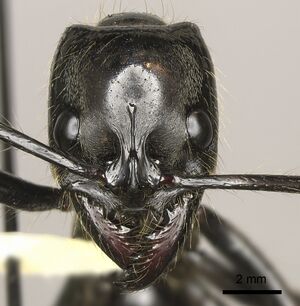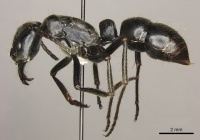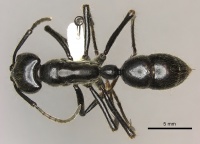Dinoponera mutica
| Dinoponera mutica | |
|---|---|

| |
| Scientific classification | |
| Kingdom: | Animalia |
| Phylum: | Arthropoda |
| Class: | Insecta |
| Order: | Hymenoptera |
| Family: | Formicidae |
| Subfamily: | Ponerinae |
| Tribe: | Ponerini |
| Genus: | Dinoponera |
| Species: | D. mutica |
| Binomial name | |
| Dinoponera mutica Emery, 1901 | |
In a study of ant diversity in the northern Brazilian Pantanal Dinoponera mutica was found in, and restricted to, semi-deciduous habitat. (Meurer et al. 2015)
Identification
Lenhart et al. (2013) - Worker. Dinoponera mutica is identified by its smooth and shiny integument with a bluish luster, a rounded pronotal corner lacking a tooth-like process, gular striations on the ventral surface of the head, long and flagellate pubescence, scape length longer than head width and petiole with even dorsal corners.
Dinoponera quadriceps is the closest to Dinoponera mutica in terms of morphological characters. Dinoponera quadriceps has a finely micro-sculptured integument which is not shiny, lacks gular striations and has a petiole which bulges on the dorso-anterior edge. Dinoponera longipes and Dinoponera hispida may also be confused with D. mutica but these species lacks the dense golden pubescence of the former, or the short, stiff setae and forward bulging petiole of the latter.
Key to Dinoponera workers / Clave para la identificación de las obreras de Dinoponera / Chave para identificação de operários de Dinoponera
Keys including this Species
Distribution
Dinoponera mutica is found in central South America in the Brazilian states of Rondônia, Mato Grosso, Goias and Mato Grosso do Sul, in eastern Bolivia and northwest Paraguay (Lenhart, Dash & Mackay, 2013).
Latitudinal Distribution Pattern
Latitudinal Range: -3.76611° to -22.809943°.
| North Temperate |
North Subtropical |
Tropical | South Subtropical |
South Temperate |
- Source: AntMaps
Distribution based on Regional Taxon Lists
Neotropical Region: Argentina, Bolivia, Brazil (type locality), Paraguay.
Distribution based on AntMaps
Distribution based on AntWeb specimens
Check data from AntWeb
Countries Occupied
| Number of countries occupied by this species based on AntWiki Regional Taxon Lists. In general, fewer countries occupied indicates a narrower range, while more countries indicates a more widespread species. |

|
Estimated Abundance
| Relative abundance based on number of AntMaps records per species (this species within the purple bar). Fewer records (to the left) indicates a less abundant/encountered species while more records (to the right) indicates more abundant/encountered species. |

|
Biology
Castes
Images from AntWeb
    
| |
| Worker. Specimen code casent0260423. Photographer Shannon Hartman, uploaded by California Academy of Sciences. | Owned by PSWC, Philip S. Ward Collection. |
Nomenclature
The following information is derived from Barry Bolton's Online Catalogue of the Ants of the World.
- mutica. Dinoponera grandis subsp. mutica Emery, 1901a: 48 (w.) BRAZIL (Mato Grosso).
- Type-material: syntype workers (number not stated).
- Type-locality: Brazil: Mato Grosso (Germain).
- [Note: Kempf, 1971: 378, proposes the type-locality as, “Rondonópolis in the center of Mato Grosso State”.]
- Type-depository: MSNG.
- Wheeler, G.C. & Wheeler, J. 1952c: 607 (l.).
- Subspecies of grandis: Emery, 1911d: 63; Mann, 1916: 408; Santschi, 1921g: 84; Borgmeier, 1923: 64.
- Subspecies of gigantea: Borgmeier, 1937b: 226.
- Status as species: Kempf, 1971: 378 (redescription); Kempf, 1972a: 97; Kempf, 1975c: 344; Brandão, 1991: 340; Bolton, 1995b: 171; Wild, 2007b: 39; Lenhart, et al. 2013: 148 (redescription); Feitosa, 2015c: 98; Dias, A.M. & Lattke, 2021: 45 (redescription).
- Distribution: Bolivia, Brazil, Paraguay.
Unless otherwise noted the text for the remainder of this section is reported from the publication that includes the original description.
Description
Worker
Lenhart et al. (2013) - (mm) (n=12) TBL: 29.42–32.34 (30.99); MDL: 4.10–5.48 (4.71); HL: 5.13–6.30 (5.65); HW: 5.13–5.64 (5.39); SL: 5.43–6.05 (5.72); WL: 7.53–8.61 (8.20); PL: 2.26–2.67 (2.41); PH: 2.82–3.38 (3.17); PW: 1.54–1.90 (1.76); GL: 8.61–11.99 (10.06); HFL: 7.18–8.00 (7.60).
A description of the morphology of the worker is given in Kempf (1971): “Antennal scape remarkably longer than head width. Pubescence on front and vertex generally longer and denser than in gigantea, but lacking the golden luster on longipes. Gular face smooth and shiny, with fine, more or less distinct striation antero-laterally and antero-mesially (sometimes nearly effaced). Sides of head smooth and shining in spite of the very fine, superficial microsculpture which is reticulate-punctate. Antero-inferior corner of pronotum obtusely angulate or rounded. Pronotal disc smooth and shiny, lacking irregular fossae and wrinkles; the paired swellings rather weakly expressed. Tarsus I of hind leg decidedly longer than head width. Petiole of distinctive shape…, shorter than that of gigantea and longipes, but width-length proportion still under 0.08; anterior and posterior upper corners subequally rounded; smooth and shining; vertical sulcus on posterior face usually obsolete, present only in one Bolivian specimen. Terga I and II of gaster very indistinctly, superficially and finely reticulate-punctate yet quite smooth and shining, lacking the dense foviolae of longipes on disc where the pubescence is likewise scarce. Stridulatory file well-developed, triangular but short, visible only when acrotergite of tergum II is fully exposed.”
Type Material
Lenhart et al. (2013) - Syntype workers, BRAZIL: Mato Grosso, Germain (leg.) (Museo Civico di Storia Naturale, Genoa) [examined] (specific locality of Rondonópolis proposed by Kempf (1971)).
References
- Albuquerque, E., Prado, L., Andrade-Silva, J., Siqueira, E., Sampaio, K., Alves, D., Brandão, C., Andrade, P., Feitosa, R., Koch, E., Delabie, J., Fernandes, I., Baccaro, F., Souza, J., Almeida, R., Silva, R. 2021. Ants of the State of Pará, Brazil: a historical and comprehensive dataset of a key biodiversity hotspot in the Amazon Basin. Zootaxa 5001, 1–83 (doi:10.11646/zootaxa.5001.1.1).
- Camargo, K.S. de. 2011. Composicao e diversidade de "Poneromorfas" (Hymenoptera, Formicidae) em duas fitofisionomias de cerrado e padroes de distribuicao de "Poneromorfas", Pseudomyrmecinae e Cephalotini (Myrmicinae) para o Brasil. Thesis, Universidade de Brasilia.
- Dias, A.M., Lattke, J.E. 2021. Large ants are not easy – the taxonomy of Dinoponera Roger (Hymenoptera: Formicidae: Ponerinae). European Journal of Taxonomy 784, 1–66 (doi:10.5852/ejt.2021.784.1603).
- Emery, C. 1901b. Notes sur les sous-familles des Dorylines et Ponérines (Famille des Formicides). Ann. Soc. Entomol. Belg. 45: 32-54 (page 48, worker described)
- Kempf, W. W. 1971. A preliminary review of the ponerine ant genus Dinoponera Roger (Hymenoptera: Formicidae). Stud. Entomol. 14: 369-394 (page 378, Raised to species)
- Lenhart, P.A., Dash, S.T. & Mackay, W.P. 2013. A revision of the giant Amazonian ants of the genus Dinoponera (Hymenoptera, Formicidae). Journal of Hymenoptera Research 31, 119–164.
- Meurer, E., L. D. Battirola, J. H. C. Delabie, and M. I. Marques. 2015. Influence of the Vegetation Mosaic on Ant (Formicidae: Hymenoptera) Distributions in the Northern Brazilian Pantanal. Sociobiology. 62:382-388. doi:10.13102/sociobiology.v62i3.359
- Ulysséa, M.A., Brandão, C.R.F. 2013. Ant species (Hymenoptera, Formicidae) from the seasonally dry tropical forest of northeastern Brazil: a compilation from field surveys in Bahia and literature records. Revista Brasileira de Entomologia 57, 217–224 (doi:10.1590/s0085-56262013005000002).
- Wheeler, G. C.; Wheeler, J. 1952c. The ant larvae of the subfamily Ponerinae - Part II. Am. Midl. Nat. 48: 604-672 (page 607, larva described)
References based on Global Ant Biodiversity Informatics
- Brandao, C.R.F. 1991. Adendos ao catalogo abreviado das formigas da regiao neotropical (Hymenoptera: Formicidae). Rev. Bras. Entomol. 35: 319-412.
- Fernández F., and T. M. Arias-Penna. 2008. Las hormigas cazadoras en la región Neotropical. Pp. 3-39 in: Jiménez, E.; Fernández, F.; Arias, T.M.; Lozano-Zambrano, F. H. (eds.) 2008. Sistemática, biogeografía y conservación de las hormigas cazadoras de Colombia. Bogotá: Instituto de Investigación de Recursos Biológicos Alexander von Humboldt, xiv + 609 pp.
- Fernández, F. and S. Sendoya. 2004. Lista de las hormigas neotropicales. Biota Colombiana Volume 5, Number 1.
- Kempf W. W. 1971. A preliminary review of the ponerine ant genus Dinoponera Roger (Hymenoptera: Formicidae). Studia Entomologica 14: 369-394.
- Kempf W. W. 1975. Miscellaneous studies on neotropical ants. VI. (Hymenoptera, Formicidae). Studia Entomologica 18: 341-380.
- Kempf W. W. 1978. A preliminary zoogeographical analysis of a regional ant fauna in Latin America. 114. Studia Entomologica 20: 43-62.
- Kempf, W.W. 1972. Catalago abreviado das formigas da regiao Neotropical (Hym. Formicidae) Studia Entomologica 15(1-4).
- Lenhart, P. A.; Dash, S. T.; and Mackay, W. P. 2013. A revision of the giant Amazonian ants of the genus Dinoponera (Hymenoptera, Formicidae). Journal of Hymenoptera Research 31: 119-164
- Santschi F. 1921. Ponerinae, Dorylinae et quelques autres formicides néotropiques. Bulletin de la Société Vaudoise des Sciences Naturelles 54: 81-103.
- Ulyssea M. A., and C. R. F. Brandao. 2013. Ant species (Hymenoptera, Formicidae) from the seasonally dry tropical forest of northeastern Brazil: a compilation from field surveys in Bahia and literature records. Revista Brasileira de Entomologia 57(2): 217224.
- Ulysséa M. A., C. R. F. Brandão. 2013. Ant species (Hymenoptera, Formicidae) from the seasonally dry tropical forest of northeastern Brazil: a compilation from field surveys in Bahia and literature records. Revista Brasileira de Entomologia 57(2): 217-224.

